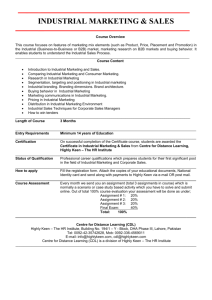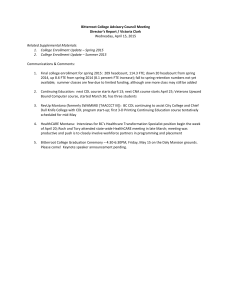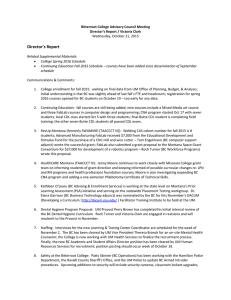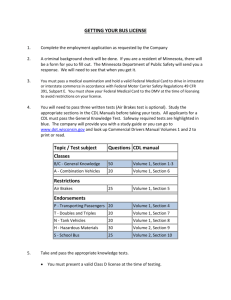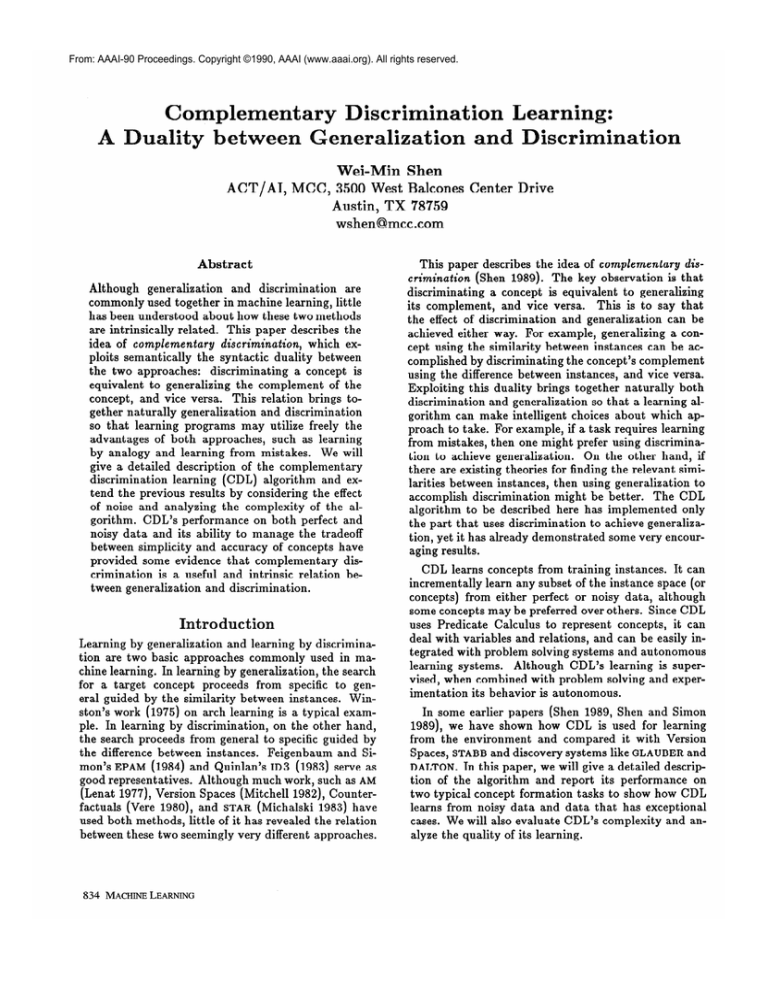
From: AAAI-90 Proceedings. Copyright ©1990, AAAI (www.aaai.org). All rights reserved.
Complementary
Discrimination
uality between Generalizatio
ACT/AI,
MCC,
Wei-Min
Shen
3500 West Balcones
Austin, TX 78759
wshen@mcc.com
Abstract
Although
generalization
and discrimination
are
commonly used together in machine learning, little
has been understood about how these two methods
are intrinsically related. This paper describes the
discrimination,
which exidea of complementary
ploits semantically
the syntactic duality between
discriminating
a concept is
the two approaches:
equivalent to generalizing the complement
of the
concept, and vice versa. This relation brings together naturally generalization and discrimination
so that learning programs may utilize freely the
advantages of both approaches,
such as learning
by analogy and learning from mistakes.
We will
give a detailed description of the complementary
discrimination
learning (CDL) algorithm and extend the previous results by considering the effect
of noise and analyzing the complexity
of the algorithm. CDL’s performance
on both perfect and
noisy data and its ability to manage the tradeoff
between simplicity and accuracy of concepts have
provided some evidence that complementary
discrimination
is a useful and intrinsic relation between generalization and discrimination.
Introduction
Learning by generalization and learning by discrimination are two basic approaches commonly used in machine learning. In learning by generalization, the search
for a target concept proceeds from specific to general guided by the similarity between instances. Winston’s work (1975) on arch learning is a typical example. In learning by discrimination,
on the other hand,
the search proceeds from general to specific guided by
the difference between instances.
Feigenbaum and Simon’s EPAM (1984) and Quinlan’s ID3 (1983) serve as
good representatives.
Although much work, such as AM
(Lenat 1977), V ersion Spaces (Mitchell 1982), Counterfactuals (Vere 1980), and STAR (Michalski 1983) have
used both methods, little of it has revealed the relation
between these two seemingly very different approaches.
834 MACHINELEARNING
Learning:
iscrimination
Center Drive
This paper describes the idea of complementary
discrimination
(Shen 1989). The key observation is that
discriminating
a concept is equivalent to generalizing
its complement,
and vice versa.
This is to say that
the effect of discrimination
and generalization
can be
achieved either way. For example, generalizing a concept using the similarity between instances can be accomplished by discriminating the concept’s complement
using the difference between instances, and vice versa.
Exploiting this duality brings together naturally both
discrimination
and generalization so that a learning algorithm can make intelligent choices about which approach to take. For example, if a task requires learning
from mistakes, then one might prefer using discrimination to achieve generalization.
On the other hand, if
there are existing theories for finding the relevant similarities between instances, then using generalization to
accomplish discrimination
might be better. The CDL
algorithm to be described here has implemented only
the part that uses discrimination
to achieve generalisation, yet it has already demonstrated some very encouraging results.
CDL learns concepts from training instances. It can
incrementally learn any subset of the instance space (or
concepts) from either perfect or noisy data, although
some concepts may be preferred over others. Since CDL
uses Predicate Calculus to represent concepts, it can
deal with variables and relations, and can be easily integrated with problem solving systems and autonomous
Although CDL’s learning is superlearning systems.
vised, when combined with problem solving and experimentation its behavior is autonomous.
In some earlier papers (Shen 1989, Shen and Simon
1989), we have shown how CDL is used for learning
from the environment
and compared it with Version
Spaces, STABB and discovery systems like GLAUBER and
DALTON. In this paper, we will give a detailed description of the algorithm and report its performance
on
two typical concept formation tasks to show how CDL
learns from noisy data and data that has exceptional
cases. We will also evaluate CDL’s complexity and analyze the quality of its learning.
The CDL
Algorithm
CDL is an algorithm that learns concepts from training
instances.
It learns a concept by learning,in
parallel,
the concept itself, C, and its complement, C. Driven by
the data, CDL will incrementally revise the complemental form, either C or c, whose prediction about a new
instance is incorrect. It will first find the differences between the new instance and the previous instances that
are correctly classified, then discriminate
the complemental form by conjoining it with the difference. After
that, CDL will update, or generalize, the complement
of the complemental
form to be the negation of the new
complemental form.
This paper uses only propositional
logic but the algorithm still works with first order logic.
Here, the
representation of instances is binary-valued feature vectors and the representation of concepts is propositional
logical formulas.
Multiple-valued
features will be represented by multiple feature variables.
For example,
if a feature F has values a, b and c, we will use two
variables zz and y so that F=a will be zy = 00, F=b
will be xy = 01 and F=c will be xy = 10. Although
features are binary-valued,
the representation
allows
Qdon’t care” (*) as a value of features so that features with unknown values can be represented.
Multiple classes (or concepts) will be represented by class
variables. For example, to learn multiple classes W, X,
Y and Z,we will use two class variables cl and c2 so that
W, X, Y and Z will be crcz = 00, crc2 = 01, crc2 = 10
and crc2 = 11 respectively.
These class variables will
be given as inputs to the learning algorithm as if they
are some extra features of instances.
Thus, instead of
telling CDL that an instance I belongs to a class C, we
willstate that (I C) is a positive instance. For example,
to say that an instance (1 0 0 1) belongs to W, we will
say that (10 0 1~1 ~2) is a positive instance; and to say
that an instance (1 1 0 0) does not belong to Y, we will
say (1 1 0 0 cl ~2) is a negative instance. Using these
class variables, CDL can learn multiple concepts even
though syntactically it learns only a single concept. For
example, W, X, Y and Z will be learned as C = (. . . W)
v (-* X) v (- - Y) v (-a Z).
Concepts will be logical propositions,
such as z A y
or f V a. The complement
of a concept will be the
negation of the concept. For example, XA y and TV~ are
complements to each other. For convenience, concepts
will be either in DNF or CNF; if a concept is in DNF
then its complement will be in CNF, and vice versa. To
classify a new instance, a concept will be matched to
the instance. For example, if the instances are vectors
of (u b c) then a concept a A b will match (1 * 0) but not
(* 0 *). As extremes, a concept T will match everything
and a concept NIL will match nothing.
Table 1 shows the core of the algorithm. The procedure IN-CLASS?(i)
serves as the supervisor; it returns
T when the instance i is positive, or NIL when i is
negative.
The procedure PREDICT&C)
returns T if i
Let C be a concept and E be C’s complement.
Let POS be a set of positive examples.
Let NEG be a set of negative examples.
Procedure CDL()
Let C be T and c be NIL;
While i t GET-THE-NEXT-INSTANCE()
If PREDICT(i,C) # IN-CLASS?(i)
then if PREDICT(i,C)=T (i.e. C covers too much)
then D +- DIFFERENCES(i,POS)
C t REVISE(C,D,NEG)
7%----C
else (i.e. c covers too much)
D + DIFFERENCES(i,NEG)
c +- REVISE(E,D,POS)
If IN .,A%$?;
then insert(i,POS)
l
eke insert(i,NEG).
Procedure DIFFERENCES(i,INSTS)
Let DIFF be { j\i 1 j E INSTS} where j\i is the set
of features that are in j but not in i;
Return the minimum subset of DIFF
that covers M% of INSTS.
Procedure REVISE(X,D,OPPOSITE)
If X=T then return D else Y +- XAD;
For each y in Y
If y is logically subsumed by some ZEY
then delete y from Y;
If y = y’~a A -~a (i.e. y contains contradictions)
then Let P=%overs no instance in OPPOSITE”,
If y’Aa satisfies P and y’Ala does not,
then replace y by y’Aa;
If y’Ala satisfies P and y’Aa does not,
then replace y by ~‘ATz else delete y from Y;
Return Y.
Table 1: The core of the CDL learning algorithm.
is matched by C and NIL otherwise (matched by c).
When a new instance comes, CDL makes a prediction
by calling PREDICT on the instance.
If the prediction
equals the value of IN-CLASS?(~),
the concepts remain
the same. Otherwise, CDL will call DIFFERENCES to
find the differences between this troublesome instance
and previous classified instances, then use REVISE to
update the complemental
form, either C or c, that
made the incorrect prediction by conjoining it with the
differences. The complement of the complemental form
is then set to be the negation of the revised complemental form.
To illustrate the procedure DIFFERENCES(i,INSTS),
consider
(abc~)}.
= (z),
i = (a&d) and INSTS = ((8kd)
(&d)
(izbzd)
Since (i&d) \ (u&d) = (ET), (Z&d) \ (u&d)
(Z?d)
\ (u&d)
= (2~)
and (a&?)
\ (u&d)
=
Among the four
elements in DIFF, the procedure will return {(E) (b 2))
because this subset is the minimum that covers all the
(bJ),
DIFF will be { (~J)(Z)((hbZ)(b;i)}.
SHEN 835
Class
+
+
+
Description
height
hair
short
blond
tall
dark
tall
blond
tall
dark
short
dark
tall
red
tall
blond
short
blond
e yes
brown
brown
blue
blue
blue
blue
brown
blue
Represent at ion
abc
d
0
0
1
0
1
0
0
0
1011
100
1
000
1
110
1
1
0
1
0
0011
Insts
0010
1000
1011
Pred
N:L
NIL
Class
c
Diff
NIL
NIL
T
NIL
T
z&d
(avd) (cvd)
1001
T
NIL
0001
1101
NIL
NIL
T
tavd) (4
zaw
NIL
kdVk
(bvavd)
Table 2: A simple learning task.
c
T
NIL
1010
T
NIL
0011
T
T
W)
(bvc)
(4
kvz
instances in INSTS. For all the experiments in this paper, the parameter M is set to 90. In a later section,
however, we will suggest a way to determine M automatically.
The result returned by this procedure is
always interpreted as a DNF logical form; so {(z) (b
Ti)} means nb’;2.
The main task of procedure REVISE(X,
D, OPPOSITE) is to conjoin
the differences D with the concept X and simplify the results.
In case when the
results contain contradictions,
the procedure also decides how to resolve the contradictions.
For example, consider D = EVb?, X = iib V cd, and OPPOSITE = { (abc$(abzz)(abc’;i)}.
Then Y will be XAD =
EbficdvEb%bcd~.
Among these literals, aba will be
deleted because it is subsumed by Eb; bcdz contains a
contradiction
and will be replaced by bed because bed
does not cover any instance in OPPOSITE while bcx does.
Let us now observe how CDL performs on the learning task from (Quinlan 1983).
Each instance is described as a conjunction of three attribute-value
pairs,
using the attributes:
height, color of hair, and color of
eyes. The instances and their representation
in CDL
are shown in the Table 2. We use variable a to represent height (0 for short and 1 for tall), bc for color of
hair (00 for dark, 01 for blond and 10 for red), and d
for color of eyes (0 for brown and 1 for blue).
The performance of CDL on this task is summarized
in Table 3. When the first instance arrives, CDL predicts that the instance is positive (C matches it), but
the prediction is wrong. Since there is no previous positive instance, procedure DIFFERENCES returns NIL and
procedure REVISE sets C to NIL and c to T. On the
second instance, CDL predicts that it is negative (c
matches it). Since the prediction is correct, the concepts remain the same. On the third instance, CDL’s
prediction is negative but wrong. This time the procedure DIFFERENCES finds the differences between (1 0 1
1) and previous negative examples (( 1 0 0 0) (0 0 1 0))
to be ZkZ~.
The procedure REVISE sets E to be equal
to the difference z&$?
(because the current c is T) and
sets C to be the new c’s complement:
(c v d)(a v d).
Based on the new concepts, CDL predicts that the
836 MACHINELEARNING
Table 3: A performance
on the learning task.
fourth instance is positive but
This time, the instance (10 0
vious positive examples (( 1 0
found is (c). This difference is
the new concept
C, (u V d)(c),
new C’s complement:
the prediction is wrong.
1) is compared with pre1 1)) and the differences
conjoined with C to form
and c
is set to be the
T&/E
CDL’s prediction on the fifth instance is correct so
concepts are not changed.
When the sixth instance
comes along, CDL predicts it is negative because c
matches the instance. Upon noticing the prediction is
wrong, CDL finds the differences between (1 1 0 1) and
previous negative examples ((0 0 0 1) (1 0 0 1) (1 0 0 0)
(0 0 1 0)) to be (5). Th us, the c is revised to be %ZV~E~
and C be (b V c) (b V a V d). Using these new concepts,
CDL predicts that the seventh instance is positive (C
matches it) but the prediction is wrong. Comparing (1
0 1 0) with the previous positive examples { (1 1 0 1)
(1 0 1 1)), CDL finds the differences to be (d). So the
concept C is revised to be (b V c)(d), and c is revised
as &Vz.
At this point, the learned concept classifies all
the instances correctly.
From this example we can see that CDL does both
generalization and discrimination,
as the way the concept C is developed.
Since CDL achieves the same
effects as any bi-directional
learning algorithm,
it is
important to point out the advantages of using complementary discrimination.
Unlike most bi-directional
learning algorithms, CDL does not require additional
domain knowledge specified a priori to bias hypothesis selection that may restrict the concepts that can
be learned (e.g., the generalization hierarchies used by
LEX). In fact, CDL can learn any subset, either conjunctive or disjunctive, of the instance space although
some may be preferred over others. CDL manages its
search by ‘jumping” to a new and reasonable hypothesis in the concept space whenever the concept is revised.
This can be seen in the way that differences are found: a
0.750
‘t
0.700
0.650
0.600
0.550
0.500
0.450 3,
0
50
100
Figure 1: CDL’s
150
200
performance
250
300
350
400
on noisy LED data.
revised concept is neither the most general nor the most
specific concept that covers the instances, but a boundary between positive and negative instances that has
the simplest syntax structure. The preference for seeking the simplest differences is the backbone of CDL’s
hypothesis selection.
Finally, although CDL currently implements
only
learning from mistakes, it can be easily extended to
similarity-based
learning as well.
For example, after
correctly predicting
the second instance is negative,
CDL could, instead of doing nothing, find the similarity
between the two negative instances (bd in this case) and
revise c by disjoining c to the similarity. CDL can also
be extended to select training instances actively; and it
has been used in (Shen 1989) to design experiments for
autonomous learning from the environment.
Experiments
To illustrate CDL’s performance
report CDL’s performance on two
ing tasks: the faulty LED display
The former data is noisy; the
noise-free, often causes problems
gorit hms.
on noisy data, we will
typical concept learndata and Multiplexor.
later data, although
for noise-tolerant
al-
Learning from Noisy Data
The LED domain, introduced by Breiman (Breiman et
al. 1984), is concerned with displaying decimal digits
using seven segments, like those on a calculator’s
display. To introduce noise, consider that each display
segment has a 10% chance to be inverted. The task is
to recognize the correct digit despite the faulty display.
Breiman has shown that for 10% noise rate, the upper
bound for the performance of any system is 74%.
We run CDL incrementally
on 400 randomly generated instances, uniformly distributed
among the 10
digits. In this experiment, each instance has 7 binaryvalued attributes representing the seven segments, plus
4 class variables to represent the 10 digits (10 classes).
Since CDL is incremental, we evaluate the performance
whenever the concepts are revised. The test data are
500 instances that are randomly
generated with the
curve is shown
same noise rate. CDL’s performance
in Figure 1. The x-axis shows the number of training
instances and the y-axis shows the percentage of correct
predictions on the 500 test instances. One can see that
the prediction rate is generally increasing with the number of instances processed. After 350 instances, CDL’s
performance is oscillating around 74% (between 72.4%
to 770/o).’ Continuing to run CDL on more instances
shows that the performance rate will stay in that range.
As a point of comparison, the performance of an nonincremental algorithm IWN is 73.3% (or 71.1%) on 400
instances (Tan and Eshelman 1988); and the performance of ID3 is 71.1% using 2000 training instances
(Quinlan 1986).
Learning from Data with Exceptional
Cases
A Multiplexor is shown in Figure 2. The inputs a and b
indicate which input among c, d,e, or f will be output
at g. Since variables are binary-valued, there are 64 possible instances in this experiment. The task is to predict
the output value given an input vector. It is difficult for
noise-free learning algorithms because the relevance of
each of the four data-bit attributes is a function of the
values of the two address-bit attributes (Utgoff 1988).
It is also difficult for noise-tolerant learning algorithms
because every training case is equally important (Wilson 1987).
The 64 instances are presented incrementally to CDL
as a circulated list. CDL’s performance
on this task
is reported in Figure 2, along with the performances
of the algorithms reported in (Utgoff 1988) and IWN.
The algorithms with hats are versions in which decision
trees are updated only when the existing trees would
misclassify the training instance just presented.
One
can see that CDL’s performance is better than others in
terms of the number of training events (instances) that
are required to reach the 100% prediction rate. Note
that time comparison
between CDL and others may
not be meaningful because CDL is tested on a different
machine.
Analysis
Complexity of CDL
In this section, we analyze CDL’s complexity based on
two assumptions:
(1) the training data is noise-free so
that the parameter M is set to 100; (2) there are no
contradictions when a concept is conjoined with the differences. The second assumption may seem too strong,
but we need it at the moment to prove the following
theorem.
‘We think the r eason that CDL’s performance is sometimes higher than 74% is that the testing data represent
only a small subset of the sample space.
SHEN 837
i
e
c
IT
i
ii
b
Algorithm
ID3
Events
53
Time
630.4
Proportion
100
1%
ID4
61
384
92.3
327.7
100
63 (not stable)
I=
ID5
384
57
258.1
184.3
50 (not stable)
100
I=
IWN
CDL
74
320
52
83.5
Figure 2: CDL’s
1;t.S
performance
100
97.6185.1
100
in Multiplexor
classified even if all the instances are processed.
CDL
must go through these “left over” instances and process
them again. In all the noise-free experiments we ran,
these instances are rare and can be cleaned up quickly.
For all the experiments in this paper, the parameter
Minprocedure
DIFFERENCES~~~~~~~
set to90. However, to learn from natural data CDL must determine
the value of M automatically.
One way to achieve this
is to initiate M=lOO and lower its value when evidence
shows that the data is noisy. This can be done at the
time of searching for the minimum subset of DIFF. If
the data is indeed noisy, then the size of the minimum
subset that covers INSTS will grow larger and the some
of its elements may only cover a single instance. When
this happens, CDL will lower M’s value so that the differences that cover single instances will be discarded.
Note that CDL remembers all the previous instances.
This could be a weak point if the number of training
instances is large. One solution is to limit the memory
to recent instances only. We have done some experiments on that matter; however, no formal analysis can
be given at this point.
domain.
The Quality of Learned Concepts
Theorem 1 Let i be a new instance
wrongly covered
by a concept X, and D be the differences found by DIFFERENCES with M=lOO.
If X cqvers POS and excludes
NEG, then the revised concept X A D will cover POS and
exclude NEG and i.
To see the theorem
is true, note that when M=lOO
DIFFERENCES guarantees that D excludes i and covers
POS. XA D will cover POS because both X and D covers
POS. XA D will exclude NEG and i because X excludes
NEG and D excludes
i.
Let I be the number of instances and A be the number of attributes of each instances. The procedure DIFFERENCES will take O(A.llog
I) because DIFF will take
O(A-I) to construct, and sorting DIFF and determining
the minimum subset of it will take O(A - I log I). The
procedure REVISE will take O(AYI+Y2)
because determining the logical subsumption
of each y in Y will take
Y2, and to resolve contradictions
takes A. Y.OPPOSITE.
To learn a concept that classifies the I instances correctly, the body of CDL will loop no more than I times
because of the theorem and the assumption of no contradictions.
Thus, the total number of attributes examined by CDL is:
I
~O(A+logi+AYi+Y2)
=
i=l
O(A?-logI+AYp+Y21)
If we relax the assumption of no contradictions,
then
the theorem will not hold because contradictions
cause
some of the literals in X A D to be modified or deleted.
In that case, there may exist instances that are wrongly
838 MACHINELEARNING
Besides time complexity,
another measure of concept
learning algorithms is the quality of the learned concepts. We will consider two aspects here: the predictive
power of the concept and the simplicity of the concept.
The concepts learned by CDL have simple structures
yet strong predictive power. For example, the concept
learned by CDL in the Multiplexor domain is the following:
&
V iibd V de
V ub j V ue j V bdf V acd V he
V cdej
It can be used to predict the output feature even if
the input features are not complete (Fisher 1989). For
instance, knowing only that features a, e and j are true,
one can conclude g even if the value of b, c and d are
unknown. The concept can also be used to predict other
features when certain features are known. For instance,
knowing that g is true and a is false, one can conclude
that c or d must be true because the concept has three
literals &, abd and acd that contain -ii, and to make g
true, one of zc, bd and cd must be true. This seems to
be an advantage over ID3 because this predictive ability
cannot be easily obtained if the concept is represented
by a decision tree.
The concepts learned by CDL also have a close relationship to classification rules.
For example, using
the variables cic2c3c4 to represent ten digits, CDL can
learn the following concept from an error-free LED
display:2
2The variables U, Ul, U,, M, Bl, B,, and B represent
the display of Upper, Up-Left, Up-Right, Middle, BottomLeft, Bottom-Right and Bottom segment respectively.
(& &MB,
B,. Bz,z2z3-c,)
v (U& U,MBlR1&z&)
v(UMBlBr~1~2~3c4)
V(iTl UrMB, BE1&Z4C3)
v(u&~&&4c3)
--
v (u~&M&&&C4C3)
v(~U,B~J&~~~~C~)
V(~&1&C&)
V(U.l~rMB~&~@&)
v (U,MBrBrz1z4c3c2)
-v(UU,MB,z1c3c2c4)
v (U~,~~~‘1c3c2c4)
---v(UU~BIBz1c3c2c4)
v (UU,MBrB~lc3c2c4)
v(U&J~MB,BF~~~-~,C,)
v (UU&MB~z2z3z4cl)
v(u&i?&2c&c~)
v (u&u,&c4&c1)
Note that each conjunction
(a single line) is like a
rule: When the segments of display matches the description, one can conclude the digit that is displaying.
For example, seeing that UlU,.mBl B,. B is displayed,
one can conclude it is a 0 (i.e. i?r&&&)
even if the
upper segment is not lit. Because the concepts learned
by CDL are very similar to rules, the algorithm can be
easily integrated with systems that solve problems and
learn by experimentation,
as we have shown in (Shen
1989, Shen and Simon 1989).
In those cases, CDL
will become an unsupervised (or internally supervised)
learner because its feedback is from the performance of
its problem solver.
Having a simplicity criterion is especially important
when the data is noisy because concepts could- overfit
the data.
Fortunately, experiments
have shown that
CDL manages the tradeoff between simplicity and predictability well. For example, after processing 400 nbisy
instances in the LED domain, the concept learned by
CDL is a DNF of 36 disjuncts.
Continuing to run on
more new instances will not jeopardize its simplicity nor
its predictive ability. We have also run CDL repeatedly
on a database of 100 noisy LED instances; the number of disjuncts oscillates between 20 and 30 and the
learned concept does not overfit the data.
Conclusion
This paper examines semantically and formally the syntactic duality between generalization
and discrimination: generalizing a concept based on similarity between instances can be accomplished by discriminating
the complement of the concept based on the difference
between instances, and vice versa. Experiments of the
CDL algorithm on both perfect and noisy data have
shown that exploiting this relation can bring together
the advantages of both generalization
and discrimination, and can result in powerful learning algorithms.
Further studies will be applying CDL to large scale
learning tasks, such as learning and discovering new
concepts in the CYC knowledge base.
Acknowledgment
ments, and members
erous support.
of the CYC
project
for their gen-
References
(Breiman et al., 1984) Breiman,
L.; Fredman,
L.H.;
Olshen, R.A.;
and Stone, C.J. 1984.
CZussificution and Regression Trees. Wadsworth International
Group.
(Feigenbaum and Simon, 1984) Feigenbaum, E.A. and
Simon, H.A. 1984. EPAM-like models of recognition
and learning. Cognitive Science, 8.
(Fisher, 1989) F’1sh er, D.H. 1989. Noise-tolerant
conceptual clustering. In Proceedings of 11 th IJCAI.
(Lenat, 1977) L enat, D.B. 1977. The ubiquity
covery. In Proceedings of 5th IJCAI.
of dis-
(Michalski, 1983) Michalski, R.S. 1983. A theory and
methodology
of inductive learning. Artificial Intelligence, 20.
(Mitchell, 1982) Mitchell, T.M. 1982.
as search. Artificial Intelligence,
18.
Generalization
(Quinlan, 1983) Quinlan,
R.J. 1983.
Learning efficient classification procedures and their application
to chess end games. In Machine Learning. Morgan
Kaufmann.
(Quinlan, 1986) Q um
* 1an, R.J. 1986. Simplifying decision trees. In Knowledge Acquisition for Knowledgebused Systems Workshop.
(Shen and Simon, 1989) Shen, W.M. and Simon, H.A.
1989. Rule creation and rule learning through environmental exploration. In Proceedings of 11th IJCAI.
(Shen, 1989) Sh en, W.M. 1989. Learning from the Environment Bused on Actions and Percepts. PhD thesis, Carnegie Melloin University.
(Tan and Eshelman, 1988) Tan,
M. and Eshelman,
L. J. 1988. Using weigthed networks to represent classification knowledge in noisy domains.
In The Proceedings of the 5th International
Machine Learning
Workshop.
(Utgoff, 1988) Utgoff, P.E. 1988.
ID5: an incremental ID3. In The Proceedings of the 5th International
Machine Learning
Workshop.
(Vere, 1980) Vere, S.A. 1980. Multilevel counterfatuals
for generalizations of relational concepts and productions. Artificial Intelligence,
14.
(Wilson, 1987) Wilson, S.L. 1987. Classifier systems
and the animat problem. Machine Learning, 2:199288, 1987.
(Winston, 1975) Winston, P.H. 1975. Learning structural descriptions from examples. In The psychology
of computer vision. MacGraw-Hill.
I thank Mark Derthick, Doug Lenat, Kenneth Murray, and two anonymous reviewers for their useful com-
SHEN 839

